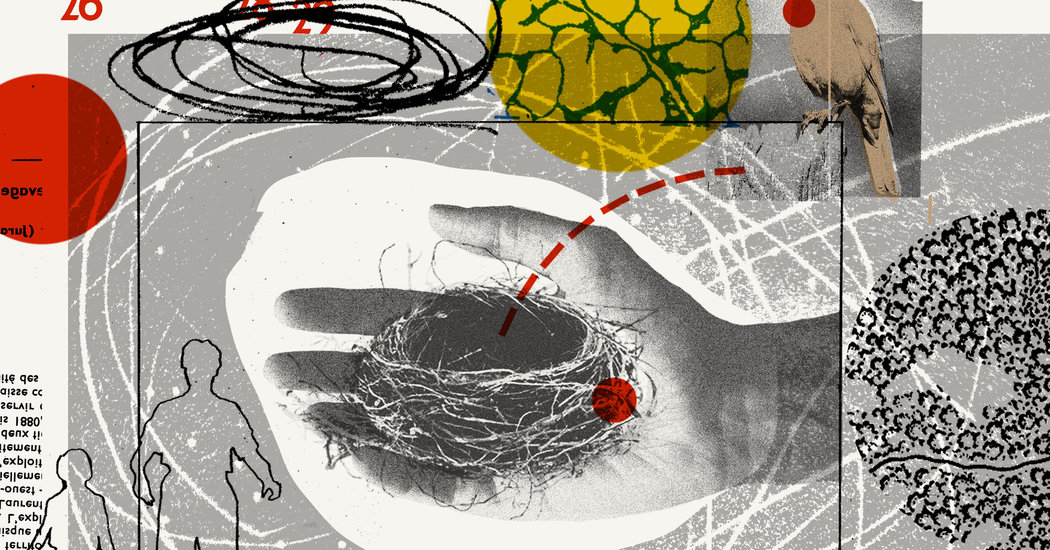
“What should I be for Halloween when I’m bald?” I asked my 7-year-old, casually tossing a long, gray-streaked handful of my hair to the ground. Sitting across from me under the trees, my daughter took videos with my phone while I clipped and shaved and attempted silly banter.
“How about a hairless cat?” she suggested thoughtfully. “Or … oh, I know! A turkey vulture!”
Like many a cancer patient facing chemotherapy, I was shaving my head in a bid for control, desperate for a small handhold in what felt like a sinkhole of dire news and ghastly medical procedures, all sucking me toward my final destination under the earth. For my daughter’s sake, I tried to appear calm, but my diagnosis — triple negative invasive ductal carcinoma, a less common and very aggressive type of breast cancer — weighed on my every thought and emotion. I’d been warned not to Google, but of course I did it anyway, and I knew the odds. They were not great.
I’d never really confronted my own mortality before, having survived nearly 49 years largely on hubris and exceptional luck. And although I’ve been a single parent since my daughter was just learning to walk, I’d managed to avoid considering what would happen to her if something were to happen to me, her primary caretaker and provider, her protector, her champion. The thought of my own life coming to a premature and painful end filled me with sorrow; the threat of leaving her motherless in this difficult world sent me into quiet, late-night paroxysms of grief that spiraled into panic attacks.
Wrestling my own terror into a chokehold, I had gently told my very sensitive child what I thought she needed to know about my health and no more. By the time our two-person, backyard head-shaving party rolled around, she knew I was sick and had already started treatment. She knew my hair was going to fall out and I would look different for a while. She knew her dad and other important people in her life would be around more often, helping to take care of her and stepping into roles that had always been mine alone. She knew too, in a general sense, what cancer is and how it’s treated. What she didn’t know (or at least, I never told her outright), was that I was fighting for my life — for our life.
When I had finished buzzing my thick, shoulder-length hair down to a crew cut, I gathered it into a pile resembling a non-hairless cat and asked my daughter what we should do with it. “We should scatter it around the yard for the birds and squirrels to make their nests with,” she replied promptly. In her serious, precise way, she pulled the hair-cat apart into tufts and walked around the yard, carefully tucking the pieces into knotholes in the fence, draping strands over low-hanging branches, hanging them like tinsel across her favorite miniature rosebushes.
Over the winter, I would occasionally notice a little tumbleweed of my hair blowing around among the dead leaves, but otherwise, I forgot about it. My days were filled with chemo, surgery, radiation, and more chemo. Heavily drugged, I scarcely left my bedroom as my body careened through a list of harrowing side effects. In between extended periods of brain-fog, I’d bury myself in the Himalayan range of insurance-related paperwork and infinite call-hold music that must accompany any serious illness in this country. Through it all, I tried to be a decent, present parent for at least a little while every day, even though I often felt half-dead already, or at least sadly removed from the life I was struggling so hard to hold on to.
By early spring, my head had sprouted a tentative layer of baby-soft, white down. My daughter had added a year to her age and at least three inches in height. I could go outside and take walks down the lane with her again, though I moved slowly and my joints creaked, as she observed, “like the Tin Man in ‘The Wizard of Oz.’” Long months of chemical warfare had left me thinner, drained and pale — somewhat vulture-like, no doubt — but it was working. With each hellish phase of the treatment triathlon, my prognosis was improving.
Then, on Easter Sunday, the two of us were outside getting ready to dye eggs when my girl came running over to me, holding something in her cupped hands. “Look, Mama! I found a bird’s nest made out of your old hair! It worked!”
About the size of my palm, the nest must have fallen from our big ash tree, the same tree that had shaded us while I shaved my head, two bleak seasons past. Frail but flexible, intricate and intact, the nest was wondrous to behold. But more amazing to me was my daughter’s happy certainty in her find, her innate understanding of nature’s ability to adapt and weave anew, even in the face of destruction.
I couldn’t explain all the ways in which her discovery defied the odds. I only said, “How lucky, right?”
Spring had come; the nest was intact. It worked.
Laurie Weed is a writer and editor who lives with her young daughter in Northern California.

